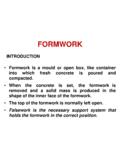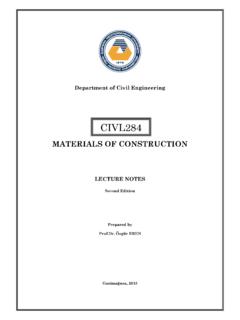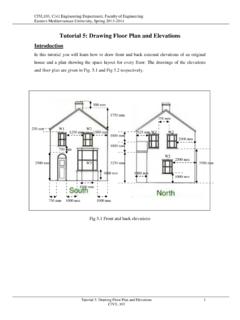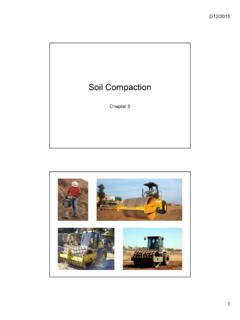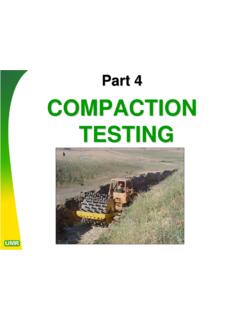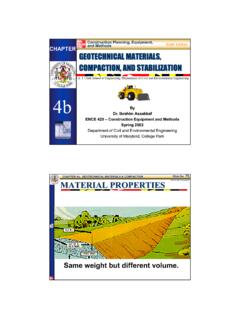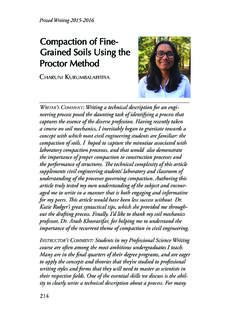Transcription of CIVL354-notes-1- Soil compaction.ppt - EMU
1 1 soil COMPACTION1 soil CompactionSoil compaction is defined as the method of mechanically increasing the density of construction, this is a significant part of the building performed improperly, settlement of the soil could occur and result in unnecessary maintenance costs yor structure all types of building sites and construction projects utilize mechanical compaction techniques. 2 Results of Poor Compaction3 compaction is a process of increasing soil density and removing air, usually by mechanical meansSOIL compaction mechanical means. 5By reducing the air voids, more soil can be added to the block. When moisture is added to the block (water content, wc, is increasing) ,,g) the soil particles will slip more on each other causing more reduction in the total volume, which will result in adding more soil and, hence the dry density will increase6hence, the dry density will increase, accordingly.
2 4 Moisture vs. soil DensityMoisture content of the soil is vital to proper acts as a lubricant within soil , sliding the particles little moisture means inadequate compaction - the particles cannot move past each other to achieve much moisture leaves water-filled voids and subsequently weakens the load-bearing highest density for most soils is at a certain water content for a given compaction effortThe drier the soil the more resistant it is tocompaction drier the soil , the more resistant it is to a water-saturated state the voids between particles are partially filled with water, creating an apparent cohesion that binds them together. This cohesion increases as the particle size decreases (as in clay-type soils). Mechanism of soil compaction :85 General Principles:The degree of compaction of soil is measured by its unit weight, and tii tttoptimum moisture content, process of soil compaction is simply expelling the air from the reducing air voids9 Reducing the water from the voids means consolidation.
3 MOISTURE DENSITY RELATIONSHIPS( soil compaction )In the construction of highway, embankments, earth dams, and many other engineering projects, loose soils must be compacted to ithiitihtincrease their unit weight. compaction improves characteristics of soils: 1- Increases Strength 102- Decreases permeability 3- Reduces settlement of foundation 4- Increases slope stability of embankments 6 Laboratory compaction :Two tests are usually performed in the laboratory to determine the maximum dry unit weight and the Standard proctor compaction Test2- Modified proctor compaction TestThe mechanical effort used is normally ramming with11 The mechanical effort used is normally ramming with a hammer for the BS light compaction test or a rammer for the BS heavy compaction relationship The aim of the test is to establish the maximum dry density that may be attained for a given soil with a standard amount of compactive effort.
4 When a series of samples of a soil are compacted at different water content the plot usually shows a distinct peak. 13 The maximum dry densityoccurs at an optimum water content For most soils and for a given compactive effort, the density of the soil will increase to a certain point, as the moisture content is increased. That point is called the maximum density. After that point, the density will start to decrease with any further increase in moisture content. The moisture content at which maximum density occurs is called the optimum moisture content (OMC). 14 Each compactive effort for a given soil has its own OMC. As the compactive effort is increased, the maximum density generally increases and the OMC The curve is drawn with axes of dry density and water content and the controlling values are values read off: d(max) = maximum dry density wopt = optimum water content 15 Different curves are obtained for different compactive efforts Expressions for calculating density A compacted sample is weighed to determine its mass: M (grams) The volume of the mould is: V (ml) Sub-samples are taken to determine the water content: w 169 The calculations are: 17 Dry density and air-voids contentA fully saturated soil has zero air content.
5 In practice, even quite wet soil will have a small air content 1810 The maximum dry density is controlled by both the water content and the air-voids content. Curves for different air-voids contents can be added to the d / w plot using this expression: 192011 Density-Moisture Relationship212212 The Standard proctor TestThe Standard proctor Test is a laboratory test used to determine the optimum water for a given compaction energy for a given soilgiven compaction energy, for a given soil . 23241325 STANDARD proctor TEST Apply 25 blows from the rammer dropped from a height of 300mm above the soil . Distribute the blows uniformly over the surface and ensure that the rammer always falls freely and is not obstructed. Place a second quantity of moist soil in the mould such that when compacted it occupies a little over two-thirds of the height of the mould Repeat procedure once more so that the amount of soil used is sufficient to fill the mould body, with the surface not more than 6mm proud of the upper edge of the mould proctor TEST As for rammer method, but the rammer has a weight of and dropped from a height of In this compaction test the mould and the amount of dry soil used is the same as for the rammer method but the heavier compactive effort is applied to the test sample.
6 The rammer has a mass of a free fall of 450bthff thil27450mm above the surface of the soil . The number of blow per layer remains the same, 25, but the number of layers compacted is increased to proctor TestThis is similar to the proctor Test except a hammer is used to compact material for greater test is normally preferred in testing materials for higher shearing both tests the compaction energy is:313217 compaction Characteristics and soil Grouping in USCSG roup SymbolCompaction CharacteristicsCompressibility and ExpansionValue as Embankment MaterialValue as SubgradeMaterialGWGoodVery LittleVery StableExcellentGPGoodVery LittleReasonably StableExcellent to GoodGMGoodSlightReasonably StableExcellent to GoodGCGoodSlightReasonably StableGoodSWGoodVery LittleVery StableGoodSPGoodVery LittleReasonably Stable when DenseGood to FairSMGoodSlightReasonably Stable when DenseGood to FairSCGd FiSli hM diRblSblGd Fi33 SCGood to FairSlight to MediumReasonably StableGood to FairMLGood to PoorSlight to MediumPoor, gets better with high densityFair to PoorCLGood to FairMediumStableFair to PoorOL, MH, CH, OH, PTFair to PoorHighPoor, UnstablePoor to Not Suitable3418 Types of CompactionThere are four types of compaction effort on yppsoil or asphalt.
7 Vibration Impact Kneading Pressure These different types of effort are found in the two principle types of compaction force: static and forceis simply the deadweight of the machine, applying downward force on the soil surface, compressing the soil only way to change the effective compaction force is by adding or subtracting the weight of the compaction is confined to upper soil layers and is limited to any appreciable and pressure are two examples of static forceuses a mechanism, usually engine-driven, to create a downward force in addition to the machine'sto create a downward force in addition to the machine s static vibrating mechanism is usually a rotating eccentric weight or piston/spring combination (in rammers). The compactors deliver a rapid sequence of blows (impacts) to the surface thereby affecting the top layers as well asto the surface, thereby affecting the top layers as well as deeper moves through the material, ttiti litidisetting particles in motion and moving them closer together for the highest density on the materials being compacted aBased on the materials being compacted, a certain amount of force must be used to overcome the cohesive nature of particular following results were obtained from a standard compaction test on a soil :Mass (g): 2010 2092 2114 2100 2055 Water content (%).
8 Value of Gs= volume of the mold is 1000 )Plot the dry density-water content curveb)Give the compaction characteristics of the soilc)Plot also the curves of zero, 5% and 10% air content )Give the value of air content at max. dry density.


